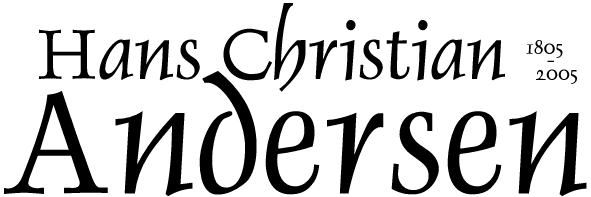

|
|
In 2005 Denmark commemorated the 200th anniversary of Hans Christian Andersen, the country's greatest storyteller, who's fairy tales have been translated in many languages and are known worldwide. It must have been a coincidence, but only a month ago the second HCA deck was added to our collection of Danish decks. So we decided to participate in the festivities by telling Andersen's own story and showing the two decks, that were published to commemorate his 150th anniversary. Who was this 185 cm tall, thin man, with a shoe size 47 and dark grey-blue eyes, set deeply in his face, who's hands were often busy cutting figures and silhouettes from paper with a large pair of scissors, that he always kept within reach, but...... also the man, who's fairy tales still know how to touch many hearts, young and old, ever since they were first published in 1837. |
|
|
|
|
|
The two decks were printed and published by Handa from Kopenhagen for export to the USA, probably as a set: both decks have the same backdesign.
|
|
|
After finishing Highschool and beginning literary success, he embarks on the steamship Dania for a first journey to Jutland in 1830. Among other towns, he visits Faaborg, and stays there with Christian Voigt, an old schoolfriend. During his stay he falls in love with Christian's sister Riborg, but she's already engaged and cannot answer to his love. |
| To overcome his broken heart, he makes his
first journey outside Denmark in 1831. He visits Germany in May and June
and publishes a travel journal afterwards. He obviously enjoys traveling and in 1833 he receives a travel grant and on the 22nd April
leaves for Italy,
where he will gather documentation for his first novel, "The Improvisatore".
The travels through Germany and from May 10 until August 15 he is in
Paris, where he visits Victor Hugo. From Paris he goes to Genève and on
September 15th he travels to Italy.
|
|
|
This first deck came without an accompanying explicative leaflet, so we can't describe all the tales that are represented here. Just the obvious ones, like "The Little Mermaid" on the Queen of Diamonds or the "Wild Swans" on the King of Hearts.
The courts are made in simple black/white designs, that look as if they were made in block-print. The characters show no facial features; they are almost made to look like the silhouettes that HCA liked to cut out. |
|
|
|
Passing through Florence he arrives in Rome on October 18 and he feels so much at home, that he remains there until February 1834, when he makes a short trip to Naples. Together with Henrik Hertz he climbs the active Vesuvius at Herculanum. He spends Easter in Rome again and leaves here on the 1st of April. He travels through Bologna, Padova and Venice to Munich, where he spends the complete |
| May month. Through Prague and Berlin, he
travels back to Copenhagen, where he arrives on the 3rd of August 1834,
full of new ideas and with enough material for several publications. His mother had died on October 7th 1833, during his stay in Italy, and he is not informed of this until December 16th of that year. In reaction he writes to a friend: "...it has, however, affected me deeply. Now I really am quite alone, - no longer is any creature bound by nature to love me".
|
|